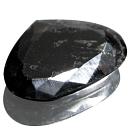|
Click on a letter above to view the list of gems. |
|
|
|
|
|
|
|
|
Wolframite
|
|
| | |
| Discovered in 1863. IMA status: Not Valid (Group name) | ||
|
| ||
|
Chemistry |
|
|
| |
|
(Fe2+;Mn2+)WO4 | |
|
|
Iron Manganese Tungstate |
|
Molecular Weight: |
303.24 gm |
|
Composition: |
Manganese |
9.06 % |
Mn |
11.70 % |
MnO |
|
|
Iron |
9.21 % |
Fe |
11.85 % |
FeO |
|
|
Tungsten |
60.63 % |
W |
76.46 % |
WO3 |
|
|
Oxygen |
21.10 % |
O |
|
|
|
|
|
100.00 % |
|
100.00 % |
= TOTAL OXIDE |
|
|
|
||||
|
Classification |
|
|
| |
|
Oxides | |
|
4/D.16-20 | |
|
|
4 : OXIDES (Hydroxides, V[5,6] vanadates, arsenites,
antimonites, bismuthites, sulfites, selenites, tellurites, iodates) |
|
Related to: |
Wolframite Group, Wolframite is chemically intermediate between Hübnerite and Ferberite with unspecified chemical composition. |
|
Synonyms: |
Cal, Call, Gal, Mock-lead, Prismatic scheelium ore, Scheelate of Iron and Manganese, Tungstate of Iron and Manganese, Tungstic acid, iron, and manganese |
|
|
|
|
Crystal Data |
|
|
|
|
|
As wedge-shaped crystals, typically flattened {100} and elongated along [010] or, less commonly, along [001], to 15 cm; faces striated k [001] or [010]; in groups of bladed crystals; massive. |
|
|
Contact twins with composition plane {100} or {023}, or more rarely {001}; also interpenetrant or lamellar. |
|
|
|
|
|
Physical Properties |
|
|
|
|
|
Perfect on {010}, Parting on {100} and {102} |
|
|
Irregular/Uneven |
|
|
Brittle |
|
|
4.0 - 4.5 |
|
|
7.58 (g/cm3) |
|
|
None |
|
|
Not Radioactive |
|
|
Other: |
Slightly magnetic. Decomposed by aqua regia with the separation of tungstic oxide. Forms pseudomorphs after Scheelite. Often more or less completely replaced by Scheelite. Pseudomorphs of Quartz, Hematite, Marcasite, and Kaolinite after Wolframite noted. |
|
|
|
|
Optical Properties |
|
|
|
|
|
Black; dark Brown in transmitted light |
|
|
Opaque |
|
|
Submetallic to Metallic Adamantine |
|
|
R1–R2: (400) 16.5–19.5, (420) 16.4–19.2, (440) 16.3–18.9, (460) 16.2–18.7, (480) 15.9–18.5, (500) 16.0–18.7, (520) 16.0–18.7, (540) 16.0–18.7, (560) 16.0–18.7, (580) 15.8–18.6, (600) 15.8–18.6, (620) 15.7–18.6, (640) 15.6–18.5, (660) 15.5–18.3, (680) 15.4–18.1, (700) 15.5–18.0 |
|
|
0.000 (Opaque) |
|
|
Distinct; Bireflectance: Weak |
|
|
|
|
|
Occurances |
|
|
|
|
|
Geological Setting: |
In high-temperature hydrothermal veins, greisens, and granitic pegmatites; also residual in alluvial and eluvial deposits. |
|
Common Associations: |
Topaz, Scheelite, Quartz |
|
Year Discovered: |
1863 |
|
View mineral photos: | |
|
|
|
|
More Information |
|
|
|
|
|
| |
|
|
|
|
There
are many localities worldwide for Worlframite. Possibly
the largest and best specimens are from the Guangdong
and Hunan Provinces,
China. |
|
|
We
have not photographed our Wolframite gems. Please
check back soon. |
